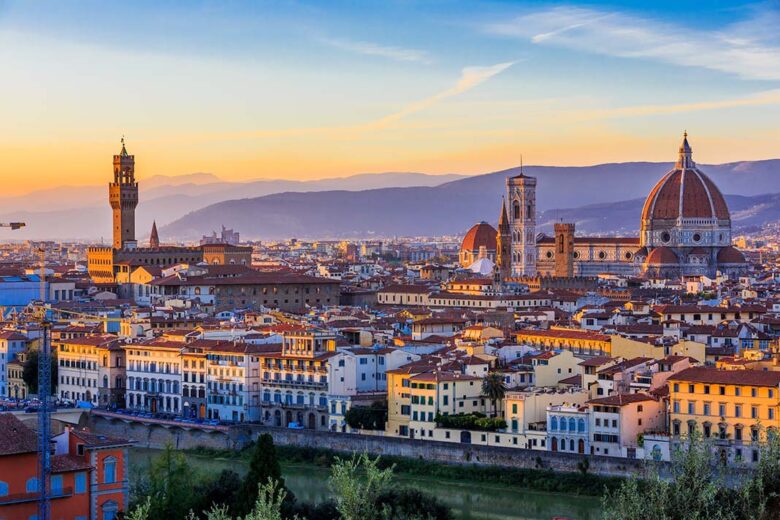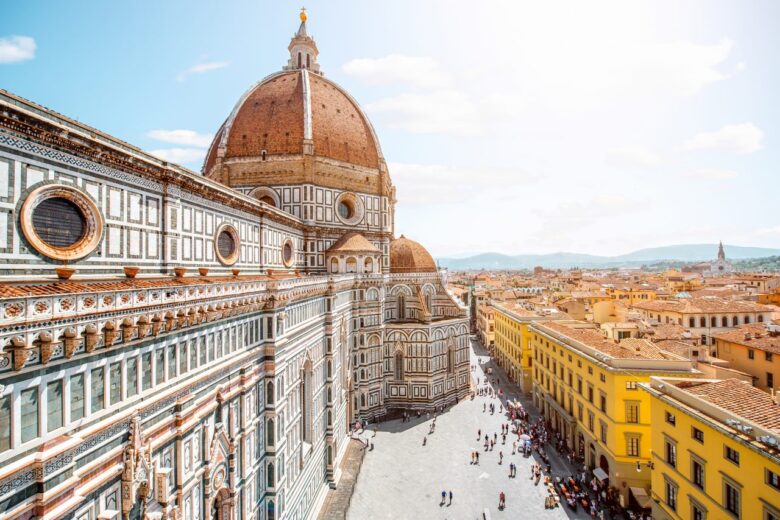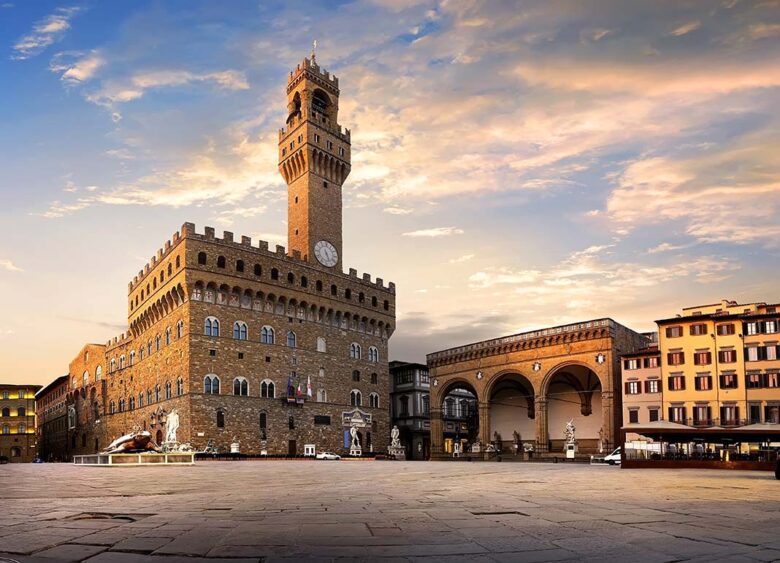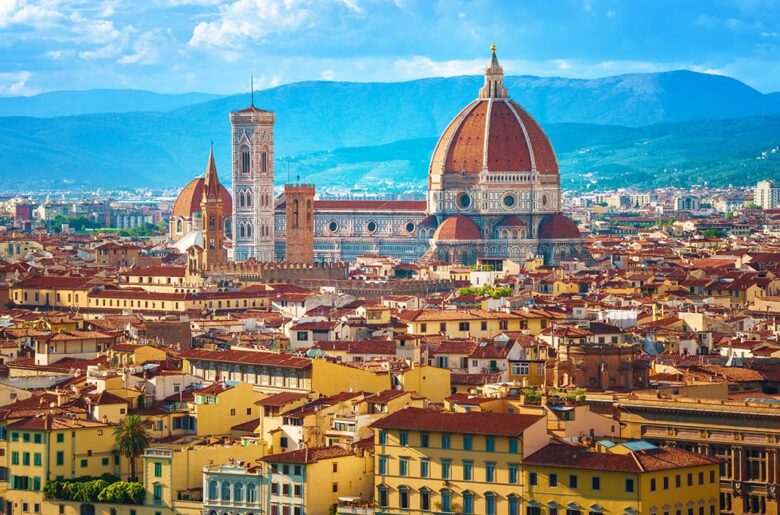
Are you wondering where to stay in Florence? In this post, we look at the best areas to stay in Flronece. Some of them are: Duomo area, Santa Maria Novella, Piazza de la Signoria, San Lorenzo and San Marco, Novoli, Santa Croce or Oltrarno.
Florence is one of the most popular destinations spots for visitors to Italy. Unlike Rome, Florence was never the seat of power for the world’s largest empire (although it was Italy’s capital for a brief window of five years), and it doesn’t bear the monuments of that legacy.
It has neither the picturesque canals that lend Venice its reputation as a grand city of romance nor the chic high fashion sensibilities of Milan. But the city of Florence has a unique beauty and personality that reflects its intellectual refinement.
As the birthplace of the Renaissance, Florence is often seen as a critical juncture point in one of the most important explosions of cultural enlightenment, and all the areas to stay in Florence bear at least some presence of the city’s rich historical legacy.
And while many of the bigger European cities have transformed into maelstroms of modern chaos, there’s still something of a small town elegance to Florence.
While there are many great neighborhoods in Florence, one thing that’s nearly universal is their accessibility. The capital of Tuscany is comparatively small when put up against some of the other major Italian cities. Because while this is definitely a modern city, you can also walk it end to end in about a half hour.
And the capital’s smart design and commitment to maintaining its sense of dignified characters means that you’ll encounter plenty of important landmarks, significant architecture, and cultural touchstones no matter what route you decide to take.
Pedestrians rule in Florence, and many of the more interesting and important streets are bereft of cars and scooters in favor of strolling individuals out on the town. Despite that, travelers looking to get off their feet will find opportunities to get around on the city’s ATAF buses.
Traditional cars aren’t suggested both because of the costly charges for taxis and the narrow streets that make navigating them a hassle.
More than any specific landmark, the architecture of the city is arguably the star of the show in the City of Lilies. The city’s caretakers have been conscientious about retaining the gorgeous Renaissance and Gotham architecture that the city is known for even as they modernize and rehabilitate the facilities available for residents and guests.
It’s a city that’s enamored with its past but not afraid to keep pace with the sorts of modern conveniences that people living in the 21st century expect. There are few places in Italy that can serve as such a savvy cross section of historical importance.
Where to stay in Florence : Best areas to stay in Florence
Florence can be more expensive than some of the southern cities like Naples. But that doesn’t mean that you’re priced out of finding areas to stay in Florence just because you’re operating on a slim budget.
We’ve identified some of the best places to stay in Florence, and we’re ready to help you understand what unique personality each brings to the table and help you identify the neighborhoods in Florence that reflect both your budget and the intent of your visit. Keep reading to learn more.
1. Duomo, where to stay in Florence for first time visitors

If you care at all about the historical importance of Florence, you’ll almost certainly want to visit the Duomo. Named after what’s arguably the most significant piece of architecture in the entire town, the neighborhood known as Duomo is dense with landmarks of immense historical importance, and it also represents the true geographic center of town.
Those two features make it a top contender for where to stay in Florence.
Lodgings in the Duomo district will put you into spitting distance of landmarks like the Museo Nazionale del Bargello – which is home to some of the most beautiful Renaissance art in the entire country – and the gorgeous and utterly unique historical religious building known as the Battistero di San Giovanni.
And while there’s no doubt that the Duomo is crowded with tourist traps, it’s also the beating pulse of the city. This isn’t just home to the ghosts of Florence’s past. It’s where so many residents live their lives.
Hidden amongst the landmarks to Florentine history are some of the coolest bars, restaurants, and clubs in Tuscany, and it’s an ideal position to set up camp and do some people watching.
The Dome itself offers some of the most stunning views of the city you’ll find anywhere, but the its selection of piazzas are just as visually appealing. They give you a nice up close and personal view into the inner lives of Florence’s residents from all walks of life.
Of course, the centralized location of Duomo means that it’s a neighborhood in high demand, especially to tourists. While you don’t have to spend a fortune to stay in Duomo, you can expect to pay more than in many other areas to stay in Florence.
Duomo offers modestly priced boutique hotels, and while the hostels tend to be a bit pricier, they’re also some of the most well appointed hostels in the city.
2. Piazza della Signoria, where to stay in Florence for sightseeing

The Piazza della Signoria has managed to retain its distinct historical personality far better than the Piazza della Repubblica.
The cobblestone streets are the same as they were hundreds of years ago, creating the impression that you’re stepping into a medieval village, and the Piazza della Signoria continues to be the heart of civic activity in the city.
While some of the northern blocks are a little more modern and less outstanding, much of this district is still composed of tight and romantically winding streets.
The Piazza della Signoria is part of the tourist center of the city, but it sits near the perimeter of that district. But it retains a reputation as the best place to go for visiting museums.
If you insist on seeing the Uffizi Gallery, Pitti Palace, and Bargello sculpture gallery in one whirlwind trip, you won’t find a better positioned neighborhood for your stay.
Just keep in mind that the streets of the Piazza della Signoria tend to get clogged with tourists during practically every season. It’s undoubtedly one of the busiest thoroughfares in Florence.
History buffs are of course the prime audience for the Piazza della Signoria, but as is the case with the Duomo district, you need to exercise some care in where you choose to stay, shop, and eat.
There are undoubtedly some diamonds in the rough in the neighborhood, but it’s also overrun with a number of tourist traps feeding off the fair weather visitors. If you want authentic dining and shopping, you may want to journey a little outside of the neighborhood to get it.
3. Piazza della Repubblica, close to everything

There was a time when the Piazza della Repubblica was the heart of the Roman forum, making it the heart of Florence in terms of commerce, culture, and economics in general. Unfortunately, much of what made the Piazza della Repubblica such a unique time capsule have been destroyed.
It rose up through the Middle Ages as the town’s civic center, but the 18th century brought the destruction of many medieval buildings for the sake of modernizing and cleaning up the space.
The Piazza della Repubblica of today may be so small to barely identify as a neighborhood, but it does have a unique identity that draws travelers from abroad. The plaza itself is a congregation point for musicians and street performers of all stripes.
It may not be as lively as some of the other piazzas in Florence, but it has personality to spare, and the piazza is lined by a number of respected restaurants and cafes.
So why stay in the Piazza della Repubblica? It’s a decent distance from the city center, making it off the most popularly populated streets and intersections, but it’s still situated close to the action in the city.
And the pulse of culture that occupies the piazza may be a bit faded, but it can still be distinctly felt. The Piazza della Repubblica was once a popular meeting spot for Florence’s artistic luminaries, and that’s still in its DNA.
You can usually find decently priced lodgings in the Piazza, at least in comparison to the more popular tourist spots.
See also: Best things to do in Florence
4. Santa Maria Novella, where to stay in Florence close to the train station

The story of is really a tale of two neighborhoods. Located on the North side of the Arno River, the bits of Santa Maria Novella that are closest to the train station can be a bit shady. It’s noisy, chaotic, and filled with traffic and more conventional buildings than the charming facades that are so prominent throughout most of the city.
But as you move away from that transit hub, you’re left with one of the most charmingly pleasant and best places to stay in Florence.
The Santa Maria Novella church after which the neighborhood is named is one of the most handsome religious buildings in town, and this neighborhood is also rich with some of the coolest but less trafficked areas in town.
If you want to see the hidden gems that Florence has to offer, Santa Maria Novella offers it in spades. Santa Maria Novella Pharmacy is a standout landmark, and while it’s still a function pharmacy, it’s a building dating back around 600 years.
The neighborhood is also home to the somber Cappelle Medicee, a mausoleum housing members of the once powerful Medici family.
If you’re looking for the cheapest place to stay in Florence, setting up shop near the train station isn’t a bad idea. While it has something of a reputation for being dangerous, it’s also incredibly affordable.
And the small size of Florence as a whole ensures that while you may be in a congested neighborhood, you’re never too far from the important cultural and historical landmarks.
The rest of Santa Maria Novella is utterly charming. It’s a little more expensive, but it’s still a far sight better than lodgings you’d find centrally located in the heart of the Duomo neighborhood. The further east you venture, the classier (and naturally more expensive) the options available to you.
5. San Lorenzo – San Marco, good priced restaurants and accommodation

The churches of San Marco and San Lorenzo occupy the anchors for two neighborhoods that combine into one of the most vast and dense stretches of urban space within the city proper.
Located at the northern edge of the tourist district, it tends to be heavily populated by visitors, and it offers eminent accessibility to the Duomo and other historic areas of Florence.
San Lorenzo is wedged between the central train station and the Duomo, positioning you well to explore both the heart of Florence and the rest of Tuscany if you choose to venture outside of the city limits.
If you choose to stay in San Lorenzo, the biggest attraction will be the proximity to Mercato Centrale. An incredibly expansive indoor food market is positioned in San Lorenzo and is one of the best places to dive in deep and explore the local flavors.
But the streets themselves are overflowing with stalls as well, and San Lorenzo is one of the best neighborhoods to visit if you’re looking to pick up some homemade Florentine leather goods without paying a premium or getting grifted by tourist traps.
San Marco, centralized around the church’s grand piazza, is also ideally located near both the Duomo and some of the most prominent art galleries and museums in town. But unlike the more heavily trafficked parts of the tourist district, San Marco is colorful, friendly, and utterly packed with family owned restaurants.
After a long day of checking out historical landmarks, the late hours and cultural diversity of San Marco make it a great place to settle in for a long dinner and a few drinks.
Both San Marco and San Lorenzo offer their distinct advantages, but their biggest selling point is that they offer you the comfort of the tourist district and the accessibility of the major historical markers while offering a vibrant glimpse into the culture and nightlife of the locals.
The diversity on display here, along with the general breadth of pricing options, make it a great place to stay for just about anyone.
6. Novoli, where to stay in Florence on a budget

Novoli wasn’t even technically a part of Florence until the 19th century, and to many Florentines, it’s still not officially a part of the city. Eminently suburban, it’s a nice change of pace from the hustle and bustle of street traffic that dominates the city center and the more tourist oriented districts.
And while this neighborhood may be one of the more sedate options within Florence, there are still some important landmarks of note that are worth your time. An Italian neighborhood wouldn’t be an Italian neighborhood without the presence of some churches, and Novoli has two worth your time.
Donato in Polverosa and Santa Maria a Novoli may be a little off the beaten path, but they’re still Renaissance highlights that are a sight to behold, and the lack of traffic means that you can more easily ruminate over their importance.
Then there’s Villa San Donato, a sprawling Paladian Palace now in ruins that’s still a thing of great beauty. In addition to housing a 14 room private museum, it also once hosted a silk factory, zoo, and railway.
Staying in Novoli means moving away from the more tourist oriented hotels and hostels that are prominent in Florence, so you may have to hunt around a little more to find somewhere worth staying here.
But a quick visit to Airbnb or a search for bed and breakfasts should find you cozy accommodations away from the activity of the city proper.
Read also: Where to stay in Rome, where to stay in Cinque Terre, where to stay in Sicily, where to stay in Sardinia, where to stay in Venice, where to stay in Tuscany
7. Santa Croce, best place to stay in Florence for dining and nightlife

Santa Croce may be within spitting distance of the important tourist landmarks, but it’s also one of the most authentic neighborhoods left near the city center.
Tourists rarely journey this far afield, and that makes it where to stay in Florence if you want to be close to the heart of everything but still immersed in the genuine experiences of the people who live, work, and play in the city. You can feel like a local in Santa Croce without having to sacrifice access to the important sights.
Once night falls, Santa Croce really comes alive. Via de’ Benici is especially well regarded for its prolific aperitivo hour, but the neighborhood as a whole is absolutely bursting at the seams with some of the most delicious and hippest restaurants and bars in town. If partying is your thing, Santa Croce really puts you in the heart of it all.
Be sure to take the time to visit Mercato di Sant’Ambrogio. This market is lively, local, and a great way to get lost in the cultural habits of Florence’s young, influential, and artistically inclined.
Santa Croce is a decent choice for anyone looking to avoid the typical tourist crowds, but it’s obviously going to be most appealing to younger and hipper crowds looking to get in the mix and enjoy the nightlife that Florence has to offer.
And walking to the neighboring region of Sant’Ambrosio will allow you to leave any vestiges of tourists behind and experience the local life up close and personal.
8. Santo Spirito – Oltrarno, great for sightseeing and drinks at night

Oltrarno stands for “across the Arno”, and it’s a pretty clear statement of intent. Positioned on the opposite side of the Arno River, Oltarno is geographically and philosophically distinct from the Duomo and the surrounding neighborhoods that constitute the most popular tourist districts.
It’s a neighborhood rife with artisans, and there’s a distinct working class vibe to the entire area. But it was once a fashionable place for aristocrats to set up their stately homes, and many of them still line the streets here.
The most prominent is Pitti Palace, which is second only to the Uffizi for its vast collection of paintings.
At the center of Oltrarno is Piazza Santo Spirito, and while it’s sometimes regarded as a separate neighborhood with a distinct personality, it would be more accurate to just call it another face of Oltrarno.
This is the social gathering spot for residents throughout Oltrarno, and it’s rich with great bars and restaurants that really ooze local flavor. It’s not the trendiest spot in town, but it’s definitely rife with authenticity.
If you do decide you want something a little hipper, the up and coming neighborhoods of San Frediano and San Niccolo are right around the corner.
If you want a quirky window into the lived experience of locals, Oltrarno is where to stay in Florence. Generations of artisans and craftsmen have called this neighborhood home, and Piazza Santo Spirito has been a hub for political workers rights movements for decades.
While it’s slowly being gentrified, it’s an affordable little neighborhood that’s nestled away from the tourist traps while still providing you with easy access to them.
9. Piazzale Michelangelo, quiet area with great views

The Piazzale Michelangelo isn’t a neighborhood in its own right, but this panoramic square offers one of the most breathtaking views of Florence you’ll find anywhere. And while you need to venture out further than Oltrarno to reach it, it’s still just a brisk walk to all of the highlights in the city.
And while tourist foot traffic to and from the Piazzale Michelangelo may be heavy on a regular basis, few visitors are sticking around. If you set up root here, you’ll largely be unbothered by the tourist crowds.
Chances are that you won’t be staying in Piazzale Michelangelo for the neighborhood itself but instead because of its close proximity to so much of Florentine life.
Its location far across the river makes it somewhat isolated from the tourist centers, but most of the neighborhoods frequented regularly by actual residents are right at your fingertips. That includes the aforementioned districts of Oltrarno, San Nicolo, and San Frediano.
If you’re staying in Florence for a while, Piazzale Michelangelo may be the right choice for you. It’s peaceful but accessible to some of the liveliest parts of town.